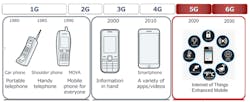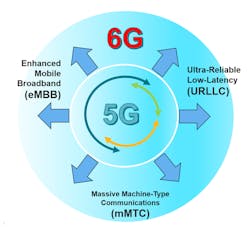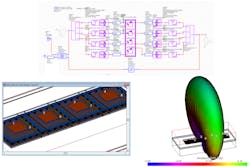The release of each new generation of wireless technology every decade or so has enabled mobile communication to progress considerably since the first portable phones appeared in the 1980s. Technical advances have created new services and business opportunities, driving what’s being referred to as the third wave of communications. The evolution made possible through 5G and future 6G technology will support even more new services for industry and society, well into the 2030s and beyond (Fig. 1).
5G represents the first step toward this next wave of services with expanded connectivity and a significant upgrade in multimedia capabilities combined with artificial intelligence (AI), machine learning (ML), and the Internet of Things (IoT). 5G will be the first generation of mobile communications to utilize millimeter-wave (mmWave) band frequencies, supporting bandwidths of several hundred megahertz and actualizing ultra-high-speed wireless data communications of many gigabits per second.
This article examines the expansion of 5G/6G wireless communications to new areas of service that will drive another industrial wave and offer greater business value for industry and society.
The Third Wave of Wireless Communications
5G and future systems will close the gap between the physical and cyber worlds. Today, mobile consumers use wireless connectivity to access the web from almost any location. In the future, high-speed coverage will be more widespread and faster, with greater emphasis on uplinking information from real-world events, either human and/or IoT, to the internet.
Once this information is in the cloud, AI could reproduce the real world in cyberspace and emulate it beyond physical, economical, and time constraints, so that “future prediction” and “new knowledge” can be discovered and shared. The role of wireless communications in this cyber-physical fusion is assumed to include high-capacity and low-latency transmission of real-world images and sensing information, and feedback to the real world through high-reliability and low-latency control signaling.
Radio communications in this cyber-physical fusion scenario correspond to the role of the nervous system transmitting information between the brain and the body. Communications convert real-world events to the cyber world through enhanced uplink capabilities and provide feedback information to humans and devices through low-latency downlink functionality.
Next-Generation Areas of Service
The next wave of communications focuses on three areas of service (Fig. 2) including:
- Enhanced mobile broadband (eMBB), which extends the current mobile experience with high data throughput on the order of more than 10 Gb/s, high system capacity on the order of more than 1000X that of LTE, and a much better spectral efficiency (3-4X) than LTE. Its use cases are high-speed mobile broadband, virtual reality, augmented reality, gaming, and more.
- Ultra-reliable, low-latency communications (URLLC), which focuses on achieving low latency, high reliability, and high availability. The expectation is for latencies of less than 1 ms. This is basically for mission-critical use cases and applications.
- Massive machine-type communications (mMTC), which provides connectivity to a huge number of devices whose traffic profile is typically a small amount of data (spread) sporadically. Consequently, latency and throughput aren’t a big concern. The main concern is the optimal power utilization of those devices because they’re battery-powered and the expectation of battery life is around 10 years or so.
Current activity in mmWave front-end design, including antenna-in-package (AiP) phased arrays (Fig. 3), large-scale beamforming RF integrated circuits (RFICs), multi-technology integration, and system-level electromagnetic (EM) analysis will all contribute to realizing New Radio (NR) access technology that can be cost effective and easy to install. This will support the small-cell networks that achieve 5G/6G performance.
Early 5G deployment and related trials have shown room for improvement in coverage and uplink performance in non-line-of-sight (NLOS) environments and heavy traffic use cases. While future system performance goals are still in the early phases of consideration, full realization of the promise of this next wave of communications creates a need for continued enhancements. Extreme performance is necessary to provide the high reliability and low latency called for by mission-critical (time-sensitive) applications such as self-driving vehicles.
6G Performance Goals
6G will implement many different technologies to achieve its performance goals. Among them will be new topologies of overlapping cells with distributed networks of beamforming antenna controlled by AI and ML to dynamically select optimum transmission paths. Previous cellular communications were based on networks of hexagonal cells spaced far enough apart to avoid signal interference with neighboring cells. In the future, there will be overlapping cells that can be dynamically reconfigured. In addition, coverage will expand through space, sea, and high-altitude drones.
New functionality in spatial multiplexing and massive multiple-input multiple-output (mMIMO) are under investigation, including the use of reflective surfaces and metamaterials to manage signal propagation in crowded urban environments with limited LOS. 6G may employ a spatially non-orthogonal, overlapped, and dynamic topology to increase path selection. Beam control through AI and ML will help reduce intercell interference at a cost of complexity.
Besides reconfiguring networks, much of the 5G/6G focus will be on physical design of radio access front ends. Strategic design partitioning, leveraging of optimal semiconductor processes, and multi-fabric assemblies will undoubtedly be utilized, calling for a range of simulation technologies, design and manufacturing flows, and tool interoperability. These trends will require software design support for co-design and co-optimization of next-generation wireless electronic systems across multiple domains—including RF, analog, and digital simulation—aided by large-scale EM and thermal analysis, and robust design verification and signoff.
A common RFIC and system-in-package (SiP) design challenge is concerned with how RF intellectual-property (IP) blocks are subject to EM, capacitive, supply, and substrate coupling. These potentially harmful interactions result from effects that occur with high-frequency signaling. Noise, either into or out of a block, can travel through the substrate or through power bussing. Placement (floorplanning) of noise-generating and noise-sensitive blocks is design critical. Parasitic coupling capacitance within/between RF blocks, and signals routed nearby (100s to 1000s of microns away) can cause disrupted performance. Self-inductance of any nets connected to the RF block, and mutual inductance between any net within an RF block to nets in neighboring blocks, is another concern.
RF IP blocks interact much differently than digital IP blocks. Most place-and-route tools aren’t able to address the unique issues confronted in integrating RF IP. An RF engineer working with RF-aware design tools is required to successfully integrate blocks at the chip, package, or board levels. To understand the effects of parasitic coupling, either capacitive, inductive, and through the substrate, closed-form distributed transmission-line models and EM analysis are essential for RF IP development.
Using higher-frequency bands in 6G (94 GHz to 3 THz) will help reduce the size of these antennas, making efforts to shrink component footprints easier. However, the antennas, feed networks, and package interconnects will all be more susceptible to parasitics and unintended coupling (crosstalk), requiring rigorous EM analysis and design verification. This move to higher spectrum will lead to a wide range of design and integration challenges.
Need for Wireless Technology Improvements
5G deployment and related trials have shown there’s room and need for improvements to the coverage and uplink performance of NLOS environments and heavy-traffic use cases. To fully achieve the promise of this next wave of communications, we’ll need continued enhancements to guarantee the high reliability and low latency necessary to close the gap between the cyber and physical worlds. 5G evolution will concentrate on better uplinking and toward more delivery guarantees, as opposed to “best effort,” with a focus on URLLC (Fig. 4).
Achieving URLLC performance with < 1-ms latency and up to “nine nines” (99.9999999%) mission-critical reliability (for factory operational technology) for networks based on edge cloud computing will require a massive number of small-cell radio access points and distributed antennas with AI/ML controlled beamsteering. Implicit in the requirements for this vast deployment of non-orthogonal networks will be the need to drive down the cost of the beamforming antenna arrays and complex receivers, especially if faster-than-Nyquist signaling techniques are applied, while greatly improving (beyond the current best effort) uplink technology.
Conclusion
A key goal of 5G has been to expand the reach and value of wireless technology beyond the individual mobile subscriber in support of mMTC and URLLC. Expanding connectivity to include network-to-smart device communications, combined with AI and IoT, will usher in a new industrial wave and offer greater business value for both industry and society.
David Vye is Technical Marketing Director at Cadence.
About the Author
David Vye
Technical Marketing Director, Cadence
David Vye is the Technical Marketing Director for AWR software at Cadence responsible for product messaging and positioning into the RF/microwave market. A former editor and business development manager for Microwave Journal, David has held a number of technical and marketing positions throughout the RF/microwave industry, including business development manager at ANSYS, product marketing manager at Ansoft Corp., senior design engineer at Raytheon Research Division and Advanced Device Center, and MMIC design engineer at M/A-COM's Advanced Semiconductor Operations. He holds a BSEE from the University of Massachusetts at Dartmouth, with a concentration in microwave engineering.




